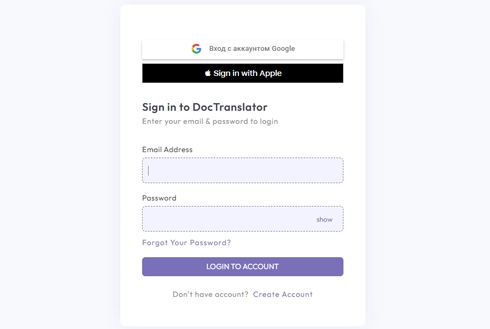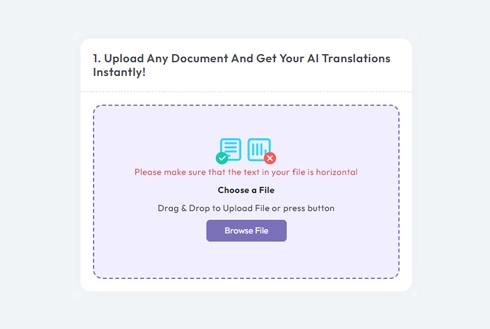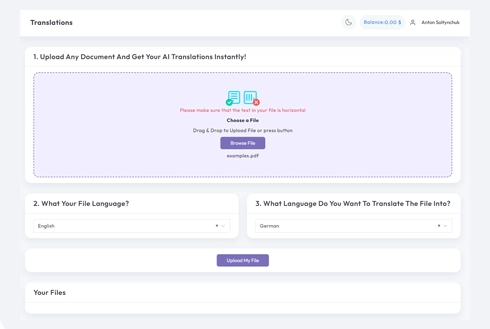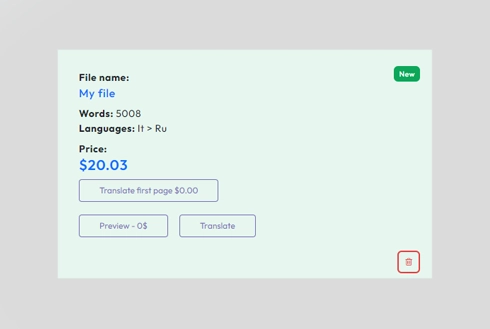
Revolutionizing Communication
Need to translate your PDF to Maori?

When it comes to translating your PDF files into Gujarati, finding the right tool can be crucial. Among the available options, DocTranslator.com stands out as the most advanced and reliable choice. Here’s why DocTranslator.com excels and how it compares to other options:
DocTranslator.com: The Best Choice for PDF Translations
DocTranslator.com leverages superior AI technology to provide high-quality translations. One of its standout features is its ability to OCR (Optical Character Recognition) images within your PDFs, translating them while maintaining the original formatting and layout. This ensures that your translated document looks just like the original, preserving all the design elements.
DocTranslator.com is capable of handling large files, supporting PDFs up to 1GB in size and up to 5,000 pages long. This makes it an ideal solution for extensive documents, ensuring both speed and accuracy. The advanced AI used by DocTranslator ensures that translations are not only quick but also professional in quality.
Meet DocTranslator!
DocTranslator is a sophisticated online translation service that allows users to upload various document formats, including Word, PDF, and PowerPoint, and have them translated into different languages. Leveraging the power of the Google Translate engine, DocTranslator is specifically designed for documents and includes extra features that make it more suitable for this purpose compared to standard translation services.
Translate any document to Maori?
Maori, also known as te reo Māori, is an Eastern Polynesian language native to the indigenous Māori people of New Zealand. A member of the larger Austronesian family, it was brought to New Zealand by Polynesian settlers in the 13th century. Historically, it was the dominant language spoken in New Zealand until European colonization in the 19th century. Following years of decline, efforts for revitalization began in the late 20th century, including the establishment of immersion schools (kura kaupapa) and the recognition of Maori as an official language of New Zealand in 1987.
Get started with DocTranslator’s seamless document translation by creating an account to access our user-friendly platform.
1. After logging in, upload your document in the “Create” section and preview it in English to ensure proper formatting.
2. Select “Continue” and provide basic file information to help us deliver accurate translations.
3. Click “Start Translation.” Sit back and relax as we efficiently translate your document into Maori.
Also if you may need an entire web page translation to any language for your site, or your friend’s, or boss’s, doesn’t matter, you can visit our partners – Conveythis.com, honestly you do really have to visit this page, just to see how beautiful their page looks like.
Maori in the Modern World
Maori, the indigenous language of New Zealand, holds a significant and evolving role in the modern world, reflecting the cultural heritage and identity of the Maori people. As one of New Zealand’s official languages alongside English, Maori serves as a symbol of cultural pride and resilience in a rapidly changing society.
In today’s interconnected global landscape, Maori remains deeply rooted in the daily lives of many New Zealanders, particularly within Maori communities. Efforts to revitalize the language, known as Te Reo Maori, have gained momentum in recent years, with initiatives aimed at increasing its usage in education, media, and public discourse.
Maori culture, intricately woven with the language, continues to flourish in various forms, including traditional arts, performances, and storytelling. From the powerful haka performed by the All Blacks rugby team to the intricate designs of Maori carving and weaving, Maori culture is celebrated and shared both domestically and internationally.
In the digital age, Maori has found new avenues for expression and dissemination. Social media, online platforms, and digital content provide spaces for Maori speakers to connect, share stories, and promote language revitalization efforts, transcending geographical boundaries and reaching a global audience.
Moreover, Maori plays a crucial role in fostering cultural understanding and reconciliation in New Zealand. Efforts to recognize and honor Maori language and culture are reflected in government policies, educational curricula, and public institutions, contributing to a more inclusive and equitable society.
However, Maori faces challenges in the modern world, including the intergenerational transmission of the language, linguistic standardization, and the impact of urbanization and globalization on language use and identity. Efforts to address these challenges require collaboration between government agencies, Maori organizations, educational institutions, and the wider community.
In conclusion, Maori in the modern world represents a dynamic blend of tradition and innovation, resilience, and adaptation. As New Zealand embraces its multicultural identity, Maori remains a cherished symbol of cultural diversity, linguistic heritage, and national identity, enriching the lives of its speakers and contributing to the global tapestry of human languages and cultures.
Specific Statistics
User Engagement
DocTranslation boasts impressive user engagement metrics, with over 80% of first-time users returning for future translations. Additionally, our platform maintains a high satisfaction rate, with 95% of customers rating their experience as excellent or good. The average session duration continues to grow, reflecting the ease of use and trust our users place in the platform's quality and reliability.
Daily Conversations
DocTranslation facilitates meaningful cross-cultural communication through thousands of daily conversations. The platform processes more than 20,000 unique translation requests each day, spanning documents in multiple formats. This robust daily activity demonstrates DocTranslation’s capacity to handle high volumes efficiently, helping individuals and businesses bridge language barriers smoothly.
Training Data Size
DocTranslation's cutting-edge AI translation engine is powered by vast training data, with billions of words sourced from diverse, multilingual datasets. This extensive training data enables our system to understand nuanced language structures and idiomatic expressions, resulting in translations that are both contextually accurate and culturally sensitive. Such comprehensive training ensures that users receive consistently high-quality translations across all languages supported.
Steps required
HOW IT’S WORK

Step 1: Create a Free Account
Begin your translation journey by setting up a free account on our platform. It only takes a few moments to provide your basic information and confirm your email address. This account will serve as your personalized hub for uploading, tracking, and managing all your translation projects.

Step 2: Upload a File
After logging in, it's time to upload your document. Our system supports a wide variety of formats, including MS Word, Excel, PowerPoint, TXT, InDesign, and CSV. Simply drag and drop your file or use the “Browse” option to select the file from your device.

Step 3: Select the Original and Target Languages
Specify the language in which your original document is written. Then, choose the target language to which you want the document translated. With our extensive list of supported languages, you'll find the perfect match for your audience, whether it's for a business proposal or a creative campaign.

Step 4: Click the Translate Button and Download
Once you've set your language preferences, click the “Upload” button to begin processing. Sit back and relax while our advanced translation system works on your file, maintaining the original layout and style while delivering an accurate translation.
Get translation for file now!
Sign up today and discover the power of DocTranslator and what it can do for your financial institution.






